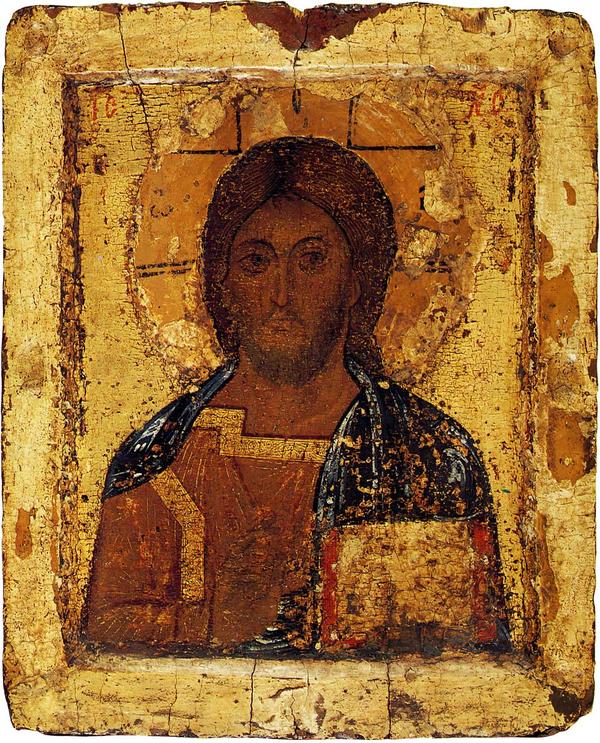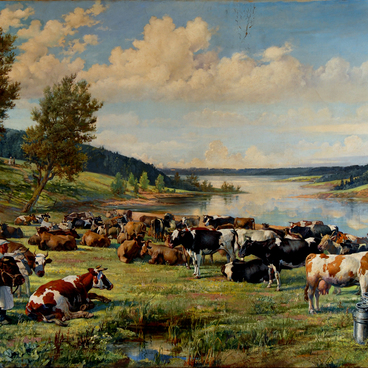The half-length depiction of Jesus Christ as the Heavenly King or Judge with the closed or open Gospel is one of the main Christian images. Therefore, it was very popular in Russian and Byzantine art — in mural and miniature painting, icon painting, small sculpture.
Christ Almighty
Creation period
Mid-19th century. Central Russia
Dimensions
30,5x25,5 cm
30.5х25.5х2.0 cm
30.5х25.5х2.0 cm
Technique
Wood (panel made of three pieces with kovcheg), two opposed inserted battens. No discernible pavoloka, levkas, tempera, silvering.
Collection
Exhibition
1
Open in app#3
Unknown Author
Christ Almighty
#2
#4
Encaustic icon of Jesus Christ from St. Catherine’s Monastery, Sinai. 6th century. Source: wikipedia.org
This type of artistic image of Christ is called “Pantocrator” in Greek, and “Almighty” in Russian art. The most ancient depiction of Christ Pantocrator was made on the 6th century Constantinople icon, which was transferred to Saint Catherine’s Monastery on Mount Sinai. In Russia, such an image of Christ appeared in the 11th century — on the mosaic of St. Sophia Cathedral in Kiev.
The icon from the exposition of the Orenburg Museum of Fine Arts was executed by a master from Central Russia in the middle of the 19th century.
#5
It repeats the contour drawing contained in the Siya Icon Painting Manual — an iconographic guide of the late 17th — early 18th centuries. The icon was created in one of the Old Believers’ centres: this is indicated by the arrangement of Christ’s left hand fingers on the edge of the Gospel, the characteristic shape of the cloak, the presence of a neckpiece decorated with pearls, the image of the Guardian Angel on the left side and other signs.
#6
The Saviour of Yaroslavl of the mid-13th century. Source: wikipedia.org
Russian Orthodox art has many famous images of Christ Almighty. One of the most ancient icons of Pantocrator is the Saviour of Yaroslavl, created in the middle of the 13th century for the Assumption Cathedral. This icon was admired by the domestic artist and restorer Igor Grabar. He believed that it was ‘as if painted surreptitiously, musefully and modestly’, but with a great sense of form.
#7
Andrey Rublev. The Saviour in Majesty, 1408. Source: wikipedia.org
The most famous icon painter of the Moscow school, Andrey Rublev, also turned to this image — in 1408 he created the Saviour in Majesty. The artist depicted Christ in a blue-green oval, which symbolizes the sky and its heavenly inhabitants. A large red square means the four cardinal points, and in the red corners are painted a lion, a calf, an eagle and an angel — the symbols of the authors of the four canonical Gospels.
#8
Orthodox Christians believe that at the icon Christ Almighty one can ask for deliverance from sinful thoughts and spiritual and physical traumas. It is also believed that it can protect against disappointment, deceits, cruelty, meanness and even shield from death and major troubles. Most often, they read the Lord’s Prayer at this icon.
#9
Orenburg Regional Museum of Fine Arts
read morehide
00:00
00:00
1x
Christ Almighty
Creation period
Mid-19th century. Central Russia
Dimensions
30,5x25,5 cm
30.5х25.5х2.0 cm
30.5х25.5х2.0 cm
Technique
Wood (panel made of three pieces with kovcheg), two opposed inserted battens. No discernible pavoloka, levkas, tempera, silvering.
Collection
Exhibition
1
Open in app
Share






